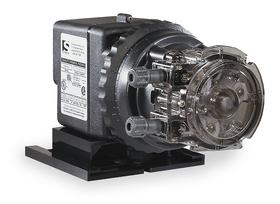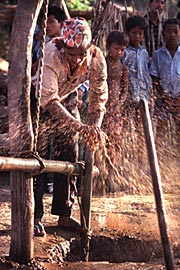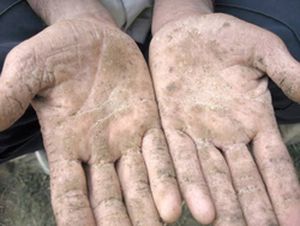July 2010
Go here if you'd like to read this issue on our website.
An email extension of the Pure Water Gazette.
In this hot July issue you'll hear about ways to raise the pH of acidic waters and learn why shampoo and chloramines don't mix. You'll hear about the clam problem in Lake Tahoe and the banning of submersible pumps in Texas lakes. Tube wells in Bangladesh and a scary dead zone in the Gulf. Hear important news about "Change Your Refrigerator Water Filter month." Learn the hazards of turning tap water into holy water and falsifying water tests. You will meet Pure Water Annie who will tell you about calcite, Corosex, soda ash and caustic soda. You'll learn about the very complex history of oysters and hear a young man's scheme to turn household waste water into electricity. Then there's a new leak protector from Watts and a really striking photo of a peristaltic metering pump. Hear about Atrazine, a new devastating oil leak in the Kalamazoo River and, as always, much, much more. The Pure Water Occasional is edited by Pure Water Gazette Editor Hardly Waite.
Water News from Around the World
While you were fanning yourself and trying to stay cool, a lot of important things happened during July. Follow the links if you want to read more.
A young British student has invented a simple and inexpensive chlorination device to provide low cost water treatment for rural India without electricity.
A Korean medical professor who invented a device to turn tap water into holy water is facing fraud charges.
Whilrpool Corporation has declared July “Change Your Refrigerator Water Filter Month", a twice a year campaign that is carried out, according to Whirlpool, “for Consumers’ well-being and wealth.” We have decided to declare August “Buy Something Really, Really Expensive from Pure Water Products Month." This campaign is being carried out to fight terrorism, global warming, and the clubbing of baby seals.
It was reported that nitrates in water may increase throat cancer in women.
Certain ingredients in shampoo, detergents and other household cleaning agents can combine with the chloramines in tap water to form cancer causing chemical agents.
In California, storage tanks from 55 gas stations are leaking gasoline, diesel, and MTBE into the water supply. Station owners are reluctant to fix the problem, so the impoverished state government is allocating cleanup funds.
Between 35 and 77 million Bangladeshis have been exposed to toxic levels of arsenic from drinking contaminated water, a public health calamity causing one in five deaths in the country, according to new research published in The Lancet medical journal.
While the BP oil spill has been labeled the worst environmental catastrophe in recent U.S. history, a biofuel is contributing to a Gulf of Mexico "dead zone" the size of New Jersey that scientists say could be every bit as harmful to the Gulf.
Scuba-diving scientists have carpeted the bottom of Lake Tahoe in an effort to halt the invasion of unwelcome Asian clams.
A water treatment salesman in ME was convicted of mail fraud for falsely reporting a water test result.
The U.S. Army Corps of Engineers has banned the use of submersible pumps in many Texas Lakes.
Several small water systems in the Laramine WY area are experiencing unsafe levels of nitrates that are blamed on leaching of urine from septic systems.
An estimated 76 million pounds of Atrazine are sprayed on corn and other field crops in the U.S. each year, Much of this ends up in rivers, streams, and drinking water supplies, yet the pesticide manufacturer is apparently being allowed to determine the chemical's safety.
A British industrial design student has created a system that transforms household wastewater to electricity.
San Diego County lowered water consumption 13% during the last physical year. Higher rates, threats of fines, and a growing conservation ethic all contributed.
American Water has donated $193 million to the international water charity Water for People.
Pollution makes a full ¼ of China’s water supply unusable and there is no hope for improvement in sight.
A 30” pipeline rupture leaked almost a million gallons of
oil into the Kalamazoo
River. The incident went almost unnoticed in the national press.
Pure Water Products is giving away some water filters. We have a few Aquasana countertops, exactly like these. The Aquasanas are brand new, they are free for the asking, and we pay shipping. One to a customer. Please use this email link to request one.
Raising the pH of acidic water
By
Pure Water Annie

Pure Water Annie, nee Constance Annette Franks, is publisher of the Pure Water Gazette and a long-time contributor of technical articles on water treatment. Because women were not taken seriously in the macho world of water treatment during the early decades in her career, she has frequently published her technical writings under such pseudonyms as Joseph F. Harrison and David Bauman. |
Let’s be clear. This article is not about “ionizers” or similarly misnamed consumer gadgets that magically amend the pH of water and contribute to the health, wealth, and happiness of the seller.
It is about the standard strategies used by water treatment professionals to raise the pH of acidic waters, most often well water, for aesthetic improvement, the protection of plumbing fixtures, or to assist in other water treatment procedures such as the removal of iron and manganese.
Two standard techniques are used: filtration and injection.
Filtration involves sending the water to be treated through a bed of a granular sacrificial medium which dissolves slowly and adds calcium carbonate to the water, thus buffering the acidity and raising the pH. The most commonly used medium for this process is calcite—a natural granular substance that provides a relatively mild upward bump in pH. Calcite is sometimes mixed with a small amount of another standard medium called Corosex which has a stronger effect on increasing pH.
| At right, a backwashing calcite filter. The domed hole near the top allows the sacrificial medium to be added. |  |
| At right, a peristaltic metering pump to deliver a soda ash solution to raise the pH of acidic water. |  |
Most filters for acid neutralization are backwashing filters, like the one pictured, but if the water is very clean—such as in post-treatment for large reverse osmosis units—in/out style upflow filters can be used. (Calcite is also available in cartridge form for post treatment for undersink reverse osmosis units.)
The only disadvantage of calcite treatment is that it raises the hardness of the treated water slightly. This is of no concern unless the water being treated is already very hard.
The second standard pH increase strategy is injection of a small amount of a pH increasing substance.
Soda Ash is the most commonly used pH increaser, but a product called caustic soda, which is about a 30% stronger pH increaser, is sometimes preferred, especially in swimming pool treatment.
Soda ash is delivered via a small injection pump, usually electric, that injects a solution of the product under pressure into the water line.
The advantage of injection of soda ash is that it does not add to hardness and it gives a more potent increase in pH. It can be used to treat water in the 5.0 range, whereas calcite filtration does not give sufficient increase to very acidic water.
Featured Water Issue : Arsenic
The US Environmental Protection Agency (EPA) maximum contaminant level (MCL) for arsenic is 10 micrograms/liter (parts per billion). That isn't much. Arsenic is very potent stuff.
Modern westerners are familiar with arsenic mainly as an exotic poison that figures in mystery novels. You put some in your enemy's tea, he takes a sip, and drops dead. However, the reality of arsenic poisoning in some parts of the world, most notably Bangladesh and some parts of India, is slow, painful degeneration leading to death, often by cancer. Common health effects are
-
Stomach pain, nausea, vomiting, diarrhea
-
Partial paralysis, numbness in hands and feet, blindness, thickening and discoloration of the skin (see the hands of the arsenic-poisoned man below).
-
Cancer of the bladder, lungs, skin, kidneys, nasal passages, liver and prostate.
The following is excerpted from "Arsenic-Laced Well Water Poisoning Bangladeshis," from the National Geographic News for June of 2003. You will note the irony of well-meaning effort at aid going wrong. A dam is a blessing for some and a curse for others.
Possibly the largest mass poisoning in history may be underway in India and Bangladesh. Pollution is not to blame. The culprit is arsenic in the drinking water, a natural phenomenon in several parts of the world, but which is particularly severe in South Asia.
Arsenic in ground water is caused naturally mainly by minerals dissolving from weathered rocks and soils. Exposure to high levels of the toxic element can cause cancers of the skin, bladder, kidney, and lung, and diseases of the blood vessels of the legs and feet, as well as possibly diabetes, high blood pressure, and reproductive disorders.
How many Indians and Bangladeshis are exposed to a high level of arsenic in their drinking water? According to the World Health Organization (WHO) in Geneva, estimates vary from a low of 28 to 35 million to a high of 77 million—more than half the population of Bangladesh, one of the most crowded nations. It is estimated that over a million Indians are also drinking arsenic-laced water. Newer cases of arsenic poisoning in the Ganges Basin suggest that many of the region's 449 million residents could be at risk.
Dipankar Chakraborti, a researcher at the Jadavpur University in Kolkatta, India believes that more than 50 million people are exposed and thousands are already showing symptoms of poisoning.
Bangladeshis are being poisoned—usually without knowing it—by drinking
water drawn from wells. Three decades ago health and development
experts, and small local contractors, dug millions of deep tube wells
throughout Bangladesh. The experts  encouraged the whole nation to drink
well water because it was deemed to be safe, free of the bacteria that
causes water-borne diseases such as diarrhea and other intestinal
maladies that have long plagued the tropical country.
encouraged the whole nation to drink
well water because it was deemed to be safe, free of the bacteria that
causes water-borne diseases such as diarrhea and other intestinal
maladies that have long plagued the tropical country.
But in switching from rivers and other surface sources of water, the people of Bangladesh may have exchanged water-borne diseases for slow poisoning by arsenic. In the 1970's public health specialists and government policy-makers were unaware of the problem. It was only in 1993 that "clean" well water was discovered to contain dangerous quantities of the poison.
"It is a terrible public catastrophe," said Allan H. Smith, professor of epidemiology at the University of California, Berkeley, and a WHO consultant who has investigated the problem in Bangladesh on several trips.
The number of people affected by the arsenic disaster ranks with those being threatened by the biggest killer diseases. "By virtue of its sheer size it is pushing the limits of our knowledge and capacity to respond to it," said Hans van Ginkel, rector of the United Nations University in Tokyo.
In a new effort to alleviate the crisis, the United States
Geological Survey (USGS) is undertaking a project in which integrated
geologic, hydrologic, and geochemical approaches will be used to
develop criteria that will identify and map sources of safe or
low-arsenic ground water. This involves the digging of new deep bore
wells which might help determine arsenic levels in both  the Meghna and
Ganges river basins.
the Meghna and
Ganges river basins.
Local people are being used to manually dig to the sort of depths that in the western world are normally accessible only with the assistance of sophisticated drilling rigs. David W. Clark, a specialist with USGS who is currently working in Bangladesh, says, "I have been amazed that the local folks are drilling wells up to 1,200 feet (366 meters) deep using no machinery of any kind. It is a lot of hard work and the drillers are very skilled and do an excellent job."
But what really intrigues Clark is watching the drillers remove the 1,200 feet (36 meters) of drill stem from the well. "The entire crew of 25 to 30 laborers would climb the derrick singing a local Bangla folk song in response to the leader…at a given point they would all jump off hanging onto a rope to try to extract the pipe…this would move the pipe a few feet," he said. "The entire process takes many hours, but it gets done."
According to the USGS the purpose of drilling these deep wells is to get a better definition of the deep aquifer system and to see if—at least in some areas—it may provide a viable source of potable water, free of arsenic.
WHO's most recent guideline for the maximum amount of arsenic in drinking water recommends 10 parts per billion (ppb). That was in 1993 when it was lowered to that level from 50 ppb. But most water consumed in arsenic-affected areas in Bangladesh has substantially higher levels, frequently far above 50 ppb.
Arsenic-contaminated water is not restricted to developing countries. In the western states of the United States of America about 13 million people drink arsenic-tainted water, albeit less contaminated than the well water in Bangladesh. Australia, too, has arsenic-contaminated water. So do Argentina, Brazil, Chile, Hungary, Mexico, Taiwan (Province of China), Thailand, Vietnam, and the eastern areas of India in Bengal.
Arsenic poisoning is recognizable from skin color changes, blotches all over the face and body, hyper pigmentation on the chest and upper arms, hard patches on palms and soles of the feet, inability to walk, debilitating pain, and watery eyes.
In the developed world, sophisticated methods of arsenic treatment exist. US well owners avail themselves of reverse osmosis, specialized filtration and ion exchange technologies to remove arsenic from water that tests a few parts per billion over the 10 ppb MCL. These technologies are not available in Bangladesh and other poor regions. A variety of simple filters have been devised to address arsenic poisoning in these regions with varying degrees of success.
For more information about arsenic and treatment of arsenic, please go to our Water Treatment Issues section.
New Products from Pure Water Products
You'll be excited to hear that we're expanding our water softener offerings.
Until now we've featured a basic line of tough and dependable water softeners made with Fleck 5600 controls. We continuing these as our "Standard" model but adding a sexier Premium line featuring Fleck 2510 controls and the water and salt saving Vortech mineral tank. We've been using Vortech tanks for some time for our large filters and are now making them available on softeners. The Vortech tank allows a significant reduction in backwash and rinse water. Finally, we now have a series twin tank Fleck 9100 softeners. Twin units offer the ultimate in water savings because they make it unnecessary to program a "reserve." This allows each tank to be used to its full capacity between regenerations.
We're expanding our filter cartridge offerings as well and are now stocking the exceptional Pentek iron removal cartridge in 4.5" X 20" size and two versions of the Pentek chloramine reduction cartridges both in 2.5" X 9.75" and 4.5" X 20".
And here's an interesting new device from Watts that will soon be on our RO Parts page and offered as an option on all new filters and reverse osmosis units.
Leak Protector from Watts
This inexpensive unit detects leaks in water filtration units and shuts off the water supply automatically when a leak occurs. It works with undersink filters and reverse osmosis units. A replaceable, water activated pad expands to shut off all water going to the water treatment unit when water touches it. The Watts Leak Protector is very easy to install, and the pads are replaceable. The only tool you'll need to install it is a pair of scissors. Best of all, no batteries or electrical connection are needed. It comes with extra pads and the whole thing costs less than $20.
And, as always, there is much, much more. So please visit our commercial websites:
Main Website, where you can find all of our products: http://www.pwgazette.com.
Pura Website: The site that sells every nut and bolt for Pura Ultraviolet Systems:http://www.purauv.com.
The home of Model 77, "the world's greatest $77 water filter." http://countertopwaterfilters.com.
Our Sprite Shower Filter (and Vitabath Vitamin C Bath Dechlorination Tablets) Site: http://www.spriteshowerfilters.com.

